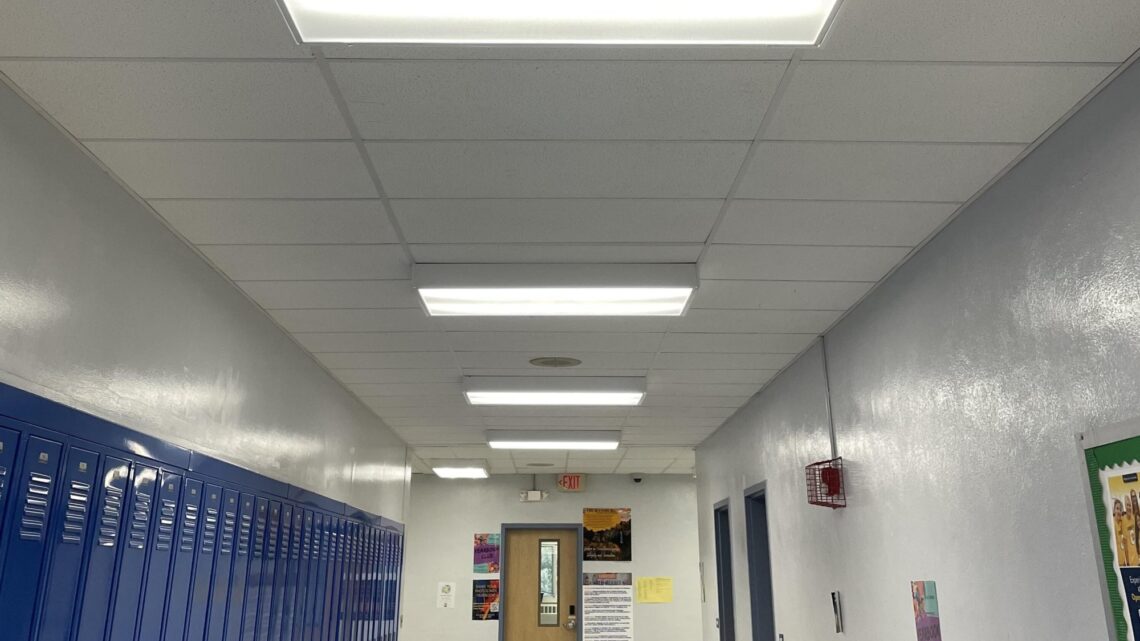Safe and Efficient Lighting

Choosing safe and efficient light fixtures can have a positive impact on the environment and health of the school community. Schools can save up to 50% on energy use by choosing more energy efficient lighting and incorporating best practices like turning lights off or dimming when not in use. Using less energy is also a climate change solution that helps the Chesapeake Bay watershed. Rising sea levels, warming temperatures, extreme weather, and seasonal changes are already impacting the watershed. Reducing the use of greenhouse gases by reducing energy consumption is a key solution that can slow and reduce future climate change impacts.
Upgrading to more efficient lighting may also improve the health and wellness of everyone inside the school building. If your school was built or renovated between 1950 and 1979, the fluorescent lights may contain Polychlorinated Biphenyls (PCBs). If PCBs leak from these lights, they can be dangerous to people's health. Upgrading to safer full-spectrum LEDs can also improve learning! Blue light (which is in full-spectrum LEDs) can make people more alert and less sleepy.
Connecting to Issue Investigation
Climate change is impacting all aspects of our lives from our health and safety to the economy, our homes and schools to wildlife habitats. Because of this, any investigation that leads students to look for climate change solutions could consider reducing greenhouse gas emissions with more efficient lighting.
For those working towards green school awards, this action can reduce a school’s environmental impact and costs in addition to improving the health and wellness of students and staff by removing harmful chemicals and improving the learning environment.
Facilitating Student Action
Students should continue to have opportunities to share ideas and opinions throughout the process of identifying, planning, and implementing action. Listed here are just a few ways students can stay engaged while working on this lighting solution—but there are many more! The complexity of each activity/task can be adjusted for each grade level.
- Monitor - students of any age can conduct an energy audit of the school, younger students can count the number of light fixtures and monitor how often lights are turned off when not in use and older students can calculate energy usage and potential savings
- Educate - students can research the environmental benefits, cost savings and health benefits for upgrading the lights and share their findings with the school administration and the broader school community
- Advocate - students could advocate for the money and materials needed to install safer and more efficient lighting by sharing their monitoring and research results to the school board through letters or presentations, students could advocate for more community support by talking with their families and local news agencies
- Share and Celebrate - students can celebrate their work by sharing cost savings from lighting upgrades and adapting best practices with the broader school community by writing articles, press releases or inviting reporters from the school paper and local news agencies
Safe and Efficient Lighting Resources
Conduct an audit at your school using the LAUNCH Toolkit: Energy Audit to learn where your school may be able to reduce energy usage or make it more efficient.
Better Buildings from the U.S. Department of Energy has created a Lighting Toolkit for K-12 schools. This extensive toolkit includes practical guides on how to reduce energy use by using more efficient lighting, installing better lighting controls and best practices, and designing spaces better.
If you fear your school may contain fluorescent lights with PCBs, the Environmental Protection Agency (EPA) has resources to share with school administrators and facility managers on the use and dangers of PCBs, possible locations of PCBs in school buildings and actions to take, and proper disposal.
